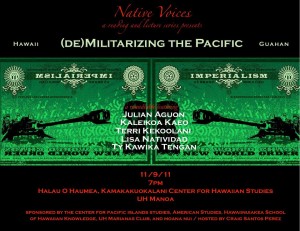“We Are the Many – Across the Pacific Blue Continent”
Listen to a podcast of the “Blue Pacific Continent” forum that was held in Guam on November 30, 2011 via Beyond The Fence, a program of Public Radia Guam- KPRG 89.3 FM:
I invite you to tune in to Beyond the Fence which airs every Friday at noon on Public Radio Guam-KPRG 89.3 FM, immediately following Democracy Now. This one hour locally produced program features interviews with diverse individuals on a variety of topics that explore the complexities of the US military presence in Guam and the Northern Mariana Islands and the challenges of building community ‘beyond the fence.’
Episode 97 “We Are the Many – Across the Pacific Blue Continent, Part II” (hosted by Dr. Vivian Dames with production assistance of Lydia Taleu) airs 12/16/11.
On 12/2/11 we aired Episode 95 “We Are Many – Across the Pacific Blue Continent, Part I” which featured presentations by Kenneth Gofigan Kuper and Victoria-Lola Leon Guerrero, two of four panelists at the public forum held at the University of Guam on November 30, 2011 entitled “The Pacific Blue Continent: Militarized Experiences in Hawai’i, the Marshall Islands and Guahan.” This forum was jointly sponsored by the Division of Social Work and the Guahan Coalition for Peace and Justice.
In Part II today, we feature the presentations at this public forum by Mrs. Abacca Anjain-Maddison of the Marshall Islands and Kyle Kajihiro of Hawai’i. They visited Guam on their return from the solidarity conference ‘For a nuclear weapon-free, peaceful Asia-Pacific without military bases” sponsored by the Japan Peace Committee held in Naha, Okinawa November 23-26. We also include part of the Q & A session with all four panelists discussing alternative uses of returned military land, island sustainability, the importance of inter-generational activism and moving from intellectual dialogue to direct action.
Mrs. Anjain-Maddison (waanjonok@yahoo.com) is a former Senator and Representative of Rongelap Island in the Marshall Islands which was most damaged by the radioactive fallout of US H Bomb tests conducted at the Bikini Atoll. As daughter of the Anjain family that led the struggle of the Rongelap people, she continues to advocate for justice and compensation for Rongelap people. She also works for the establishment of the Rongelap Peace Museum to make known the nuclear tragedy of their island to the people of the world. She has participated in the 2008-2010 Bikini Day events, the 2010 New York Action and the 2010-2011 World Conference Against Nuclear Bombs [see also Ep. 12 (4/9/10) “Environmental Justice and Radiation Exposure”].
Kyle Kajihiro (kyle.kajihiro@gmail.com) is a 4th generation man of Japanese ancestry who was born and raised in Honolulu. He has worked on peace and demilitarization issues since 1996 with the American Friends Service Committee Hawai’i Area Program, which is now Hawai’i Peace and Justice. He coordinates activities and communication for the DMZ Hawai’i- Aloha ‘Aina network and is involved in campaigns to protect various sites on the island of Oahu from US military activities. He writes and gives talks about the demilitarization movement in Hawai’i and travels throughout the Hawaiian islands to build solidarity on these issues. He has also been involved in anti-racist/anti-fascist issues, immigrant worker organizing, Central America solidarity, and community mural, radio and video projects [see also Ep. 18 (5/21/10) “From One Politically Colonized People to Another: Guahan and Hawai’i Solidarity” ].
Audio podcasts of all episodes are available for free and may be downloaded within five days of the original broadcast date by going to the Beyond the Fence link at www.kprgfm.com or directly to http://kprg.podbean.com/.
Please forward this announcement to your respective networks and encourage listeners to submit their comments on line. Suggestions for future topics and guests may be sent to vdames_uog@yahoo.com.
Thank you for supporting public radio for the Marianas — and for listening to and promoting Beyond the Fence, locally and abroad.
Be sure to tune in next Friday for a special compilation of Christmas Memories Beyond the Fence.
Vivian Dames, Ph.D.
Public Radio Guam, KPRG -FM 89.3
Beyond the Fence
Anchor Host/Coordinator








